S-21 Interrogator Testifies About Physical Mistreatment of Prisoners
Today, former S-21 guard, typist and interrogator Lach Mean told the Court about practices of interrogations, torture and confessions. He specified which forms of physical coercion were used to extract confessions from prisoners. He also talked about three cases of moral offences, two of which he explicitly classified as rape. At the end of the day, a discussion took place as to the extent that a torture tainted document could be used in Court.
Nuon Chea present in the court room
All parties were present except National Civil Party Lead Co-Lawyer Pich Ang, who was absent during the first session due to personal reasons. Nuon Chea was in the courtroom in the morning, but the court had received a waiver of Nuon Chea. Witness 2-TCW-931 was on the reserve.
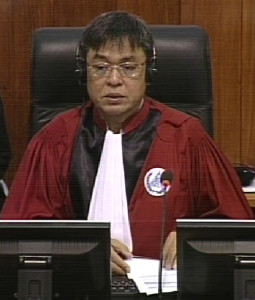
Judge Nil Nonn
Assistant Prosecutor Andrew Boyle said that they had requested in an e-mail an additional twenty minutes to question this witness. The request was granted. Trial Chamber President Nil Nonn then sought clarification about the status of Nuon Chea: First, had he made the decision to be in the court room from now on? Second, if that was the case, why had there been a waiver submitted to the Chamber? Third, if he wished to make a statement, he needed to inform the Chamber of the purpose of the statement in form of a summary first.
Nuon Chea Defense Counsel Victor Koppe said that their client had informed them at 08:45 am of his desire to make a statement related to the Vietnam invasion and also its relation to S-21. He did not believe that this statement was directly relevant to the witness, but to the segment in general. He said that this was a temporary withdrawal of his waiver, but that Nuon Chea’s health would not allow him to sit in courtroom all day. Mr. Boyle said that the Co-Prosecutors had no objection to Nuon Chea making a statement, but that an answer should be given as to whether he subjected himself to questioning. Moreover, he requested to bring the witness out of the court room if the defense’s request was to be granted.
After conferring with the bench, the President sought clarification as to whether Nuon Chea wanted to answer questions from the parties or the Chamber, which Mr. Koppe categorically denied. The President then announced that Nuon Chea was allowed to be in the court room until such time that he decided to go downstairs again. The Chamber would decide later whether Nuon Chea was allowed to make a statement. If he was allowed to do so, this would take place at the end of the testimony.
Interrogations, torture and confessions
The floor was granted to the Co-Prosecutors. Mr. Boyle returned to the topic of torture. He asked whether Kak used torture in the observation session that the witness attended. The witness said that he did not know anyone called Kak. He then confirmed, after pronouncing the name differently, that he saw Kak beating and torturing people. He beat them and used electricity shocks. He would stick the wire to the ear of the prisoners. He would not touch the prisoners with the electric wire anywhere else. He could see that the prisoners were in pain when being electrocuted.
The witness himself was allowed to torture prisoners if the decision was made to do so. “It was Hor who made that decision”.
Mr. Koppe interjected and objected to the terminology used by the prosecution. He argued that on the one hand, there was torture and on the other inhumane and degrading treatment. “Beating prisoners lightly” did not necessarily amount to torture. “Light beating is not necessarily torture. Everything needs to be viewed on a case by case basis”. Mr. Boyle responded that if they were referring to a European court and other specific decision, they should do a filing to which the parties responded.
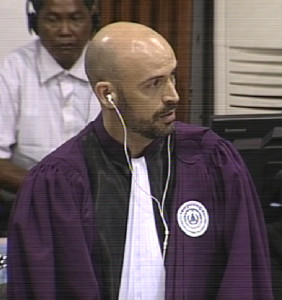
International Assistant Prosecutor Andrew Boyle
Moreover, the witness had not referred to “light beating” but to “beating” and had described open wounds and scars on the bodies of the prisoners. Judge Claudia Fenz said that defense counsel had objected to the use of the term torture when using it too freely. She advised Mr. Boyle to use the term more carefully
Mr. Boyle inquired whether the witness had used these methods of beating and electrocuting or also additional methods. Mr. Mean replied that “sometimes I use it. But I never practiced any other methods of torturing”. He did not know what methods other interrogators used and whether they had to seek permission. Mr. Boyle referred to his Written Record of Interview, in which he had said that the more senior cadres did not have to seek permission to torture.[1] Mr. Mean answered that he was not really aware of the position of more senior interrogators. They were trained for approximately one week or one month about which methods should be used for interrogation to extract confessions quickly. This training session also dealt with policy issues. Ta Duch and Ta Hor were the instructors. He did not know whether other people used specialized methods in other teams. Mr. Boyle then wanted to know whether there were specialized teams for torture as he had indicated in his statement.[2] He replied that such a special team probably existed.
There were many people who received torturing. There were only few cases where prisoners were not tortured during the course of their interrogations.
Mr. Boyle pointed to the witness’s DC-Cam statement. Mr. Mean had told DC-Cam that he had only interrogated one prisoner without physical coercion.[3] The witness confirmed this.
There was only one prisoner who was interrogated without any beating. Many other prisoners who were interrogated mostly received torture during the course of the interrogation.
There were no instructions to threaten family members. “But there were instructions to extract information about the network or string of the prisoners.” Mr. Boyle referred to a 26 September 1976 Report that indicated that Duch provided instructions to “recall the welfare of his spouse of his wife and children and his knowledge of their arrest”.[4] Mr. Boyle asked whether he had received similar instructions. He confirmed that there were similar instructions.
Next, Mr. Boyle wanted to know how long the shortest interrogation lasted.
If the prisoner agreed to cooperate and give the answer, the duration of the interrogation would last around ten days, and the shortest one would be around one week.
The longest one would last up to one month. The morning session for interrogation would last from 7 am until 11 am, and the prisoner would then be brought back in at 1 pm. This last session would last until 5 pm. At night time, the prisoner would be interrogated from 6 pm until 10 pm. When prisoners could not give any answers anymore then interrogation came to a conclusion. Mr. Boyle sought clarification as to who made that decision about when a prisoner was not able to give any more information. Mr. Mean said that this depended on the prisoner.
Mr. Boyle wanted to know whether he ever received feedback for the confessions, for example that the confession was incomplete and he had to receive more information. The witness replied that Duch sometimes gave feedback through telephone calls that those prisoners who already confessed had not given all answers yet. This particular prisoner would then be brought back in again. If the prisoners implicated senior officials, such as Son Sen, the instruction was to let prisoners implicate anyone. There were cases in which prisoners implicated Ta Son Sen, Ta Vorn Vet and Ta Nuon Chea, and “we allowed them to answer according to their wishes”. Mr. Boyle read an excerpt of the witness’s statement. He had called Duch to check whether he should include Vorn Vet’s name, which Duch had first not allowed, but then called back later to make Mr. Mean write it into the confession again.[5] Mr. Mean confirmed this and said that he could recall having first being instructed by Duch to skip the name, but then being instructed to put it in again. He checked with Duch, because he was afraid that this was a serious implication. Duch made him write it down two or three days later. He did not know who Duch checked it with.
Mr. Boyle finished his line of questioning and handed the floor to the Civil Party Lead Co-Lawyers.
Female prisoners and women at S-21
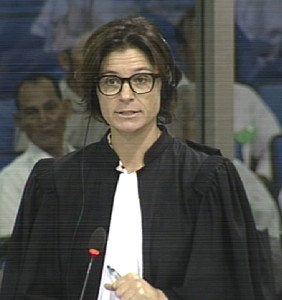
International Civil Party Lead Co-Lawyer Marie Guiraud
International Civil Party Lead Co-Lawyer Marie Guiraud started her line of questioning by asking who interrogated female detainees. He replied that Ta Pon and Ta Chan interrogated them. There was only one female cadre at S-21: Phon Svay. Duch’s wife did not live on the compound. Heng’s wife also had access to the interrogation facilities. She did not know whether these interrogated female prisoners. Ms. Guiraud referred to his DC-Cam statement. He had indicated that there were no female interrogators.[6] He recounted now that Kak would sometimes interrogate female prisoners, but also Ta Pon and Ta Chan usually. Mr. Mean never interrogated female prisoners, but he used to type confessions by female prisoners when being interrogated by other interrogators. The interrogators were Kak and Norn.
There were no specific instructions to interrogate female prisoners. “They were all considered our enemy” and they had to search for the link to enemies. He was not allowed to attend the interrogations of female prisoners. During these sessions, “the room was fully locked”. Usually only the interrogator and the female prisoner were present in the closed room. He never attended an interrogation of female prisoners and only typed the confessions of the female prisoners when he received the confession to copy it.
Rape
One woman cut her abdomen open with razor. He did not witness the act himself, but saw that the medic treated her. The medic told him that she had cut herself open and was arrested because she had had an affair with a man and had been pregnant.
He saw that an interrogator had “an immoral affair with a woman”. He recounted and incident of rape at S-21: “He drugged her and she became unconscious. He then sexually raped her. And actually the person went to the top floor and jumped off and got entangled in the electric cables and was arrested.”[7] He could not remember the name of the interrogator, but said that it might have been Touch. She referred to his testimony, in which he had said that the interrogator had took the female detainee to a room during a meal break.[8] She asked whether he remembered other instances. He replied that one messenger by Hor or Chan had raped a female prisoner “under the staircase”.
The President interjected and said that Ms. Guiraud had run out of time. She requested an additional 15 minutes. After briefly conferring with the bench, the President granted her request. The President then adjourned the hearing for the first break.
After the break, Ms. Guiraud sought more detail about the rape of a woman by Hor or Chan’s messenger. Mr. Mean recalled that she was being brought to the holding cell after the interrogation. The messenger raped her at the staircase. “I heard and saw about that incident”. He did not witness it with his own eyes, but people who worked inside, instructed the “people who worked in that compound not to follow the example of the messenger”. He did not recall whether he was already an interrogator or still a guard when this incident took place. He did not know what happened to the female prisoner or “how she felt about that”. He had not heard about any other incidences.
Turning to her next topic, Ms. Guiraud wanted to know whether the Vietnamese detainees that he had mentioned were civilians or soldiers. He replied that they were soldiers. Vietnam attacked Cambodian territory in 1978, so most of the Vietnamese prisoners were soldiers. Pon and Chan were the interrogators for the prisoners. They had interpreters who translated between the prisoners and interrogators. They also filmed and showed this film to S-21 staff. The film showed the interrogations and Vietnamese prisoners giving confessions.
He did not know much about the rules for interrogations, since they were conducted in Vietnamese. “I only saw it on the film”. He believed that only Vietnamese soldiers were brought in. With this, Ms. Guiraud finished her line of questioning.
Judge Jean-Marc Lavergne had one additional question: were those who committed rape punished, and if yes, what kind of punishment did they receive? Mr. Mean replied that the person who “committed wrongdoing” was aware that he had done something wrong and tried to escape by jumping from the top floor. The messenger who raped the female prisoner under the staircase disappeared later, but he did not know what happened to him. Mr. Mean then clarified that the first interrogator attempted to commit suicide but was caught in the electric wires and was arrested. “Moral discipline was the strictest discipline applied to everyone”, all throughout the country, he said.
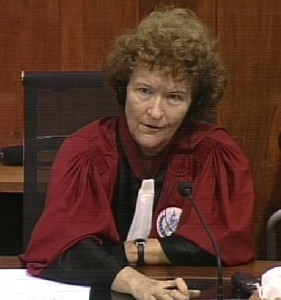
Judge Claudia Fenz
Judge Claudia Fenz asked whether there was a “prison directive” that dealt with cases in which guards had sexually assaulted detainees. He answered that “during the regime, even besides the prisoners, we were not allowed in engaging in moral offence”. Moreover “we at S-21 were strictly prohibited from committing moral offences” with female detainees, and would otherwise be treated as enemies. The order came from the cadres. He received the instruction from the chief of the guard unit. There were some who committed moral offence and were punished. The medic Soeung was accused of having moral offence with a patient. He was also a messenger of Hor. He was sent to Prey Sar for a few months. To his knowledge, Duch ordered the punishment. The medic had been raised by Duch and had been ten years old in the beginning.
Moral principles and offenses
Before handing the floor to the defense teams, the President announced that Nuon Chea would be allowed to make a statement at the conclusion of the testimony of this witness. Mr. Koppe said that they would need the whole afternoon session for questioning the witness and requested Nuon Chea to be allowed to give the speech tomorrow morning. The President granted this request.
Mr. Koppe then asked whether the witness was aware of the 12-Principles of a Revolutionary. Mr. Mean said that he remembered them at the time, but had forgotten some of them by now. Moral offence was one of the principles. Mr. Koppe asked whether he remembered Principle 6:
Do not behave in any way that violates females
The witness confirmed this. This applied to both inside and outside S-21. Mr. Koppe then asked whether these twelve principles had already been introduced in 1968. The witness did not know this.
Mr. Koppe said that the incident at the staircase had been discussed in a meeting, during which cadres had been warned not to follow this example and wanted to know whether he had understood him correctly. The witness answered that this was correct and that they were instructed not to engage in such conduct. Mr. Koppe wanted to know whether Duch referred specifically to Principle 6. The witness replied that they were instructed not to violate women. Perpetrators were punished. He was “surprised and scared” upon hearing the punishment of the cadres. “Touch was so scared of being punished, this is why he ran up the building”.
Mr. Koppe asked whether it was correct that he had worked at Ta Khmao and then at Phsar Thmey and Tuol Svay Pray, which the witness confirmed. Mr. Koppe wanted to know whether it was correct that he was working as a guard there and had no knowledge of where the prisoners went subsequently. Mr. Boyle interjected and observed that these two were separate questions. Mr. Koppe asked the witness whether he had only been a guard, which he confirmed. Some of the prisoners were later allowed to work outside and water the plants. He was not aware of prisoners being released. “My main task was to guard them, but I did not know what happened to them after they finished interrogating them”. Mr. Koppe referred to one of his interviews, in which he had said that Ta Khmao prison belonged to “S-21 network”.[9] Mr. Mean explained that Ta Chan brought him also to S-21. Mr. Koppe then wanted to know which prison he meant when referring to the PS or PJ prison. He answered that it was a prison that previously had been police headquarters. Mr. Koppe asked whether it was the same as Dam Pheng prison. He answered that he was not sure whether PS was the same prison as PJ.
Doubts raised by Duch
After the break, the President sought opinion of the two defense teams regarding two documents that the Prosecution intended to use for witnesses 2-TCW-913 and 2-TCW-816.[10] Khieu Samphan Defense Counsel Anta Guissée said that there was no issue in their eyes. Nor did the Nuon Chea Defense Team have any objections.
Mr. Koppe asked whether the witness recalled who was in charge of Ta Khmao Prison and Prey Sar in 1976 and 1977. Phal was in charge of Ta Khmao Prison, and Por was in charge of the security guards. He had not heard of Nhak alias Sen. He said that Prey Sar belonged to the S-21 network. Huy was in charge of Prey Sar.[11] Before being assigned to Ta Khmao Prison, he was assigned to study in the area. After lunch time, he was sent to dig canals near Choeung Ek. He studied politics and technology at Ta Khmao. He was with Division 703 at the time. He was not certain whether Division 703 was in charge of the rice fields at Choeung Ek.
Mr. Koppe sought his reaction to a statement by Duch, who had been confronted with Mr. Mean as a person who interrogated detainees at S-21.[12]
So I would like to raise my observations and my suspicions regarding certain points in his testimony. I did not want any militia districts to be part of my staff. I only want youths who did not actually involve in any unit or group yet to be recruited to be part of my staff, and this person, this Lach Mean, caused me hesitation to decide what type of person he was; whether he actually came to work at S-21. I am still uncertain on this matter.
As for Mr. Mean’s claim to have called Duch on his phone, Duch said:
This is very strange. When he interrogated a person named Pen Samorn and I tried to research, based on the list of S-21, but I could not find such a name, and the combination of all these points make me hesitated to confirm my position, and I will try to look through the list again to find his name; that is, the name of the interrogators at S-21.
The witness replied that Duch did not know him well. Mr. Boyle interjected and said that Duch had said that there was an interrogator called Lach Mean at S-21 after doing research. He confirmed that he was not allowed to go outside of the compound even at lunch or dinner time. He never had contact with guards who were in charge of guarding outside the compound. They were not aware of each other. “We knew only people in our team. For people in other units, we knew each other’s face”. This was because they were not allowed to go outside.
Interrogations
Mr. Koppe referred to his testimony, in which he had said that the interrogation rooms were outside the premises of Tuol Sleng.[13] The witness confirmed this now. There was another fence that separated the main building from the location of interrogations. About fifty meters away from the prison compound, there was a fence. The interrogators interrogated the detainees in front of the compound. The person in charge of the list of prisoners collected information about the prisoners. However, the interrogations and questioning was not done in that building. They never allowed guards of staff to see the interrogation in the compound, because the interrogation was confidential.
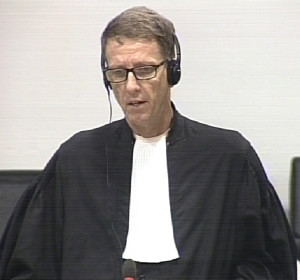
International Nuon Chea Defense Counsel Victor Koppe
Prisoners who were interrogated were questioned separately in order not to be seen by other staff or prisoners. Mr. Koppe presented an S-21 circular to the witness.[14] He asked him to look at number 3 of the first page that read: “while on guard duty … it is absolutely prohibited … to open the door or to look at the prisoners.” He confirmed that they were prohibited to ask any prisoners about their stories. Their duty was to guard the prisoners. Mr. Koppe pointed out number 5, which said out’: “do not threaten or beat the prisoners held at our place. If the prisoners disobey the rules or ignore warning, report immediately to those responsible orally or in writing”. Mr. Mean confirmed this. The witness said that prisoners were ordered to take off their clothes except their shorts, since they were concerned that they would use their clothes to hang themselves. However, most of the prisoners who came in were shirtless already. Mr. Koppe said that Rule 12 seemed to imply that they had to wear their shirts. The witness said that the statement read out by Mr. Koppe was not consistent. Prisoners were usually brought in only with shorts. Mr. Koppe pointed to paragraph 3 on page 3. The witness said that they had to prevent prisoners from communicating and be vigilant in their guard duties. Mr. Koppe then asked whether it was correct that there were 127 guards inside the compound at the point. Mr. Mena answered that he did not know even the number of units. “We were not allowed to know such detail”. In each building, there were three teams of guards. Mr. Koppe wanted to know whether he knew that there were 14 medical staff members. The witness replied that he did not know the total number of guards. He only knew one medic well. He was most likely called Neng. Mr. Koppe referred to the guards who were posted inside the “Special Room” and wanted to know whether these guards, who guarded 42 people, were posted inside the compound. Mr. Mean replied that he did not know where these people were posted. He remembered that there was one building where special prisoners were detained.
Next, Mr. Koppe showed the witness another document and asked him whether he knew Tuy Teng on that list.[15] Mr. Mean replied that he could not recall this name. He recalled the name Oeung, since they were in the same team.
Mr. Koppe then presented a few photographs to the witness.[16] He asked whether Mr. Mean had ever used these methods himself that were portrayed at these paintings. At this point, duty counsel interjected and said he would have to consult with his client, since this might lead to self-incrimination. The witness answered that he never saw such torture and never used such form of torture. Mr. Koppe asked whether he had ever seen any bathtub that was used for a form of waterboarding during interrogations. The witness replied that he saw a water container. Mr. Koppe asked whether it would be fair to say that these images came from the imagination of Vann Nath, since every cadre seemed to have testified the same thing about this. At this point, Mr. Boyle objected, saying that it called for speculation and that this classified other cadres’ testimonies. Mr. Koppe rephrased his question and asked whether Vann Nath had ever seen these methods that were shown on the painting. Judge Fenz interjected and said that this presented the same issue. Mr. Koppe dropped the issue due to time issues.
Mr. Koppe pointed to photograph 52. He said that there was an English translation (The Last Executioner – Dunlop) of these nine regulations.[17] Mr. Koppe asked whether these regulations were hanging somewhere on the compound of S-21. He replied that he used to read these regulations but could not recall them.
Cadres at S-21
Mr. Koppe asked whether he saw Son Sen coming to S-21 to teach or to instruct. Mr. Mean answered that he saw Son Sen when he came to conduct political training at S-21. “To my recollection, he came rather frequently”. This was around four or five times. He said that it was likely that Son Sen came to conduct training almost every month.[18]
Mr. Koppe asked whether he saw Son Sen three or four times in 1978, which the witness confirmed. He could not recall the content of the study sessions that Son Sen conducted. Mr. Koppe referred to a message from Son Sen to Duch that said that confessions had be thorough and that “scribbling and guesswork” was not to be accepted.[19] He said that he had not heard about this message. He recounted that Ta Hor and Duch had instructed them to be thorough in their interrogations and that they had to make sure that the enemy did not say anything that was not true. To attain this goal, they had to make sure that the prisoners did not tell them lies. Sometimes they had to threaten the prisoners “to ensure they gave us the right answers”.
At this point, the President adjourned the hearing for a break.
Leaving S-21
In the last session, Mr. Koppe asked about the last day that he was in S-21, namely January 7 1979. Mr. Mean could recall the date. On the day that the Vietnamese troops arrived, after having finished their work session, they went to the dining hall. Duch instructed them to take weapons and defend their position near the sewage canal. By around 3 pm they retreated to the banana planation near Boeung Tuom Poung. At night time, they had to swim over the river. He panicked, since he had not been in such a situation before and they could hear gunfire along the main road and trucks arriving. They were the last batch, since they were ordered to defend the position. There was no order by his group to destroy documents. “It is possible that another group was assigned to destroy the internal documents”. He did not bring any documents with him. He only had a gun with him and the shirt and shorts that he was wearing.
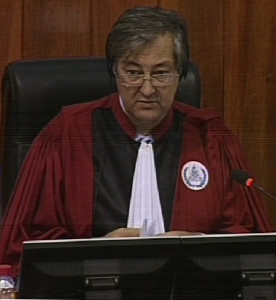
Judge Jean-Marc Lavergne
Mr. Koppe referred to a document called The Last Joint Plan and asked whether he had heard of this.[20] The witness replied that he had never heard of this. Mr. Koppe said that under B, it said that the Vietnamese were the implementers of the Soviets. Judge Lavergne interjected and asked for the basis of this document and whether these were not confessions. Mr. Koppe responded that some of the content certainly referred to confessions. However, Civil Party lawyers had been able to question him and that there were several sources for this document.
Judge Lavergne said that the reasons provided did not reach the standard that was sufficient to provide as a sound basis for questions. Mr. Koppe snapped back “if that is the case, then many questions shouldn’t be asked”. Judge Lavergne was visibly upset and told Mr. Koppe: “Listen, don’t be stupid”, before conferring with the bench about that matter.
The floor was granted to Judge Lavergne to issue an oral ruling. He said that the defense team was not allowed to use the document, since it was the result of information obtained through confessions.
Enemies
Mr. Koppe requested to make a specific exception in relation to one page in the document.[21] This referred to Koy Thuon’s confession. The Defense Team had requested to be able to use Koy Thuon’s confession, since they believed that they were not the product of any confession. Judge Lavergne instructed him not to use this part. Mr. Koppe said that “It must be because I’m stupid, but I’m not sure I understand your ruling”.
Mr. Koppe read an extract of a female cadre’s DC-Cam statement. She had said that they “were going to erupt” in late 1977, but that it was exposed and that Khuon was arrested.[22] Mr. Koppe said that there was a coup d’état by several divisions, in which they had planned to attack Phnom Penh and asked whether this was something that the witness had heard during the interrogations. Mr. Boyle objected on the basis of first asking open questions and also to classifying evidence Mr. Koppe provided a Division 310 cadre’s statement. This person had talked about a plan to liberate and control Phnom Penh.[23] Mr. Koppe asked again whether he had heard about such a plan. Mr. Mean replied that he had not heard about this plot. When Mr. Koppe sought more clarification, Mr. Boyle objected on the basis of saying that the knowledge of this witness would only be based on confessions and interrogations. The objection was upheld.
Mr. Koppe cited another document, in which Son Sen had given information about enemies that had been arrested, Chhuk, Ya, and Chakrei, who had engaged, according to Son Sen, in rebellious activities trying to overthrow the revolution.[24]
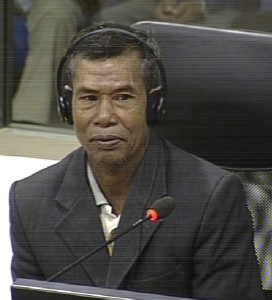
Witness Lach Mean
Mr. Koppe wanted to know whether the witness had heard similar things at the study session in 1978, which the witness confirmed. Angkar had instructed them about the purpose of the enemy. Mr. Koppe wanted to know whether they had any intelligence mechanisms to come to this conclusion. At this point, International Civil Party Lead Co-Lawyer Marie Guiraud interjected and said that counsel was leading witness to speculated. Judge Fenz said that it would have been an open question if he had stopped earlier without giving examples, but instructed the witness to answer the question nonetheless. Mr. Mean replied that he did not know about the sources of Son Sen about this knowledge. When asked about an explosion close to the Museum of Fine Arts, he said that he had heard from Duch that “the enemy” threw grenades, but could not remember about the location of it. He could not recall any details of it.
He had never heard of Yen Sambath. The most important traitor was Phim according to Duch, the witness said, and the lowest one Chakrei. Sao Phim came from the yuon Communist Party, Mr. Mean said. He did not know when Sao Phim died and only knew that Duch said that Phim was a traitor. He did not know whether Duch knew about this. However, Duch had told them that Sao Phim was a traitor. He could not recall when Duch told him this.
When Mr. Koppe wanted to provide the document that he had been prohibited to use earlier as a source, Judge Fenz said that he had been prohibited of using this document. Judge Lavergne said that he was misrepresenting the document. Mr. Koppe said that he had not used the document with the witness, but only to show the Chamber where he got the information from: “but obviously you don’t really care”.
He proceeded to refer to another document, which referred to a labor’s party and wanted to know whether Koy Thuon had been a member of this party.[25] Mr. Mean said that he could not remember all the six names mentioned in the document.
Mr. Koppe then presented a photograph to the witness.[26] The witness did not know the person’s name. Neither did he know the name Tuy Kim. He only knew Ron and Mon at S-21, who were the wives of the S-21 cadres.
Mr. Koppe referred to another document that related to the interrogation of female prisoners.[27] Mr. Mean replied that he did not know whether there were female interrogation units, but that usually Chan’s and Pon’s bodyguards took the female prisoners to the interrogation. Mr. Koppe then wanted to know whether the witness interrogated at least one female prisoner, which the witness denied. Mr. Koppe referred to a list of prisoners and asked whether he knew a female prisoner called Koam Lim.[28] The witness denied this. Mr. Koppe said that Duch had testified that Mr. Mean had interrogated Koam Lim.[29] Mr. Mean said that this was not true.
The President adjourned the hearing. It will continue tomorrow, April 27, 2016 at 9 am with the testimony of 2-TCW-931.
[1] E3/7641, at 00363557 (EN), 00363680 (FR), 00162777 (KH).
[2] E3/7641, at 00363559 (EN), 00363683 (FR), 00162779 (KH).
[3] E3/7660, at 00335287 (EN), 00057066-67 (KH), 00338005 (FR).
[4] E3/154.
[5] E3/7641, at 00363559 (EN), 00363684 (FR), 00162779 (KH).
[6] E3/7660, at 00338010 (FR), 00057072 (KH), 00335291-92 (EN)
[7] In his testimony of August 4 2009, he had indicated that it was the interrogator who attempted to commit suicide by jumping from the top floor.
[8] E3/7468, at 11:02; 00360333 (FR).
[9] E3/7641, at 00162772 (KH), 00363674 (FR), 00363552 (EN).
[10] E319/46.3.1, E319/46.3.2
[11] E3/7641, at 00363552 (EN), 00162773 (KH), 00363674 (FR).
[12] E3/7467, Testimony by Duch on August 3, 2009, at 16:04
[13] E3/7641, at 00363558 (EN), 00162777 (KH), 00363681 (FR).
[14] E3/8386, at 00521631 (EN), 00002637 (KH), 00532732 (FR).
[15] E3/844, at 00040218 (KH), 00342738 (EN), 00716260 (FR).
[16] E3/9431, at picture 43 (00198072) and 37 (00198066).
[17] E3/2817, at 00370297 (EN).
[18] E3/7641, at 00363560 (EN), 00162779 (KH), 00363683 (FR).
[19] E3/1047, at 00002455 (KH), 00548892 (EN), 00802230 (FR).
[20] E3/527, at 00285361-62 (KH), 00069031 (EN), 00314947-48 (FR).
[21] At 00069054 (EN), 00285388 (KH), 00314970 (FR).
[22] E3/7540, at 003377312 (EN) 00364274 (FR), 000550759 (KH).
[23] E3/7535, 00032408 (EN), 00087817 (KH), 00324206 (KH).
[24] E3/807, at 00933839 (EN), 00052306 -07 (KH), 00323925 (FR).
[25] E3/7327, at 01113795 (KH).
[26] E3/2117, at 00081403 (EN), 00193010 (KH).
[27] E3/1570., at 00154228-9 (KH), 00154214-15 (FR).
[28] E3/2089, at 00244255 (EN), 00404092 (KH).
[29] E3/7468, August 4, 2009 at 12:06.

[…] also S-21 Interrogator Testifies About Physical Mistreatment of Prisoners, The Cambodia Tribunal Monitor, April 26, […]